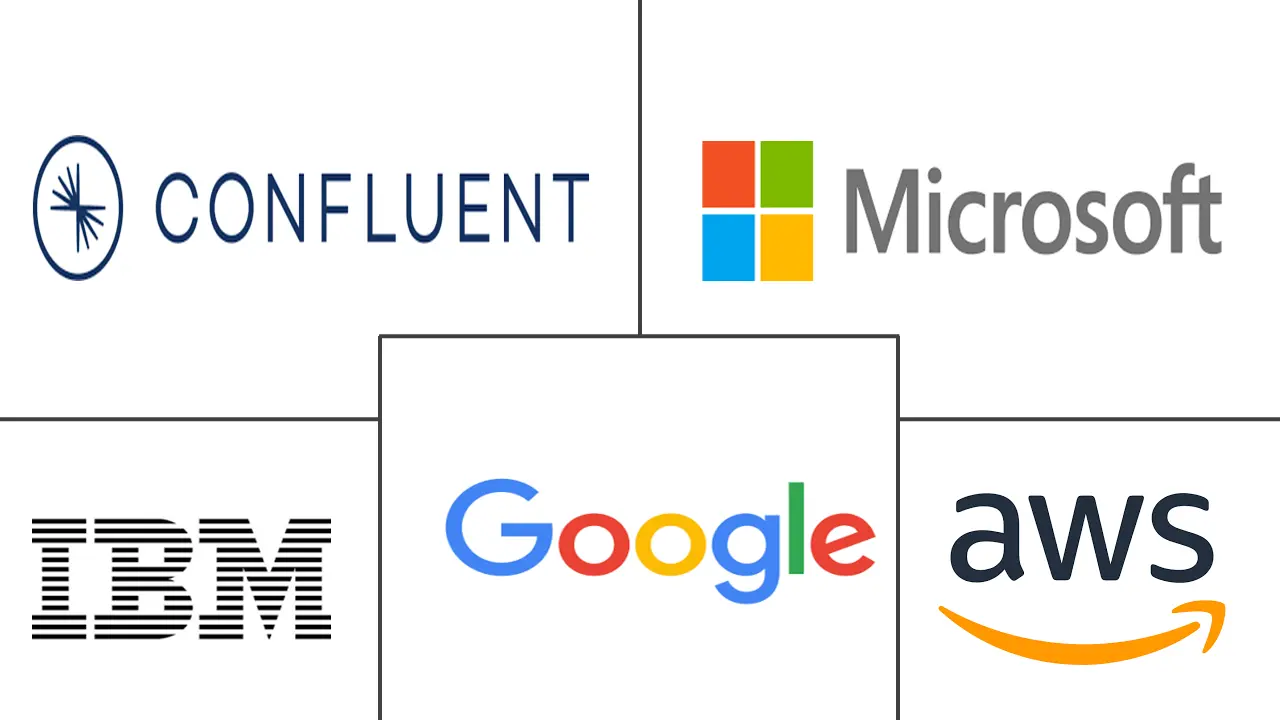Event Stream Processing Market Size and Share
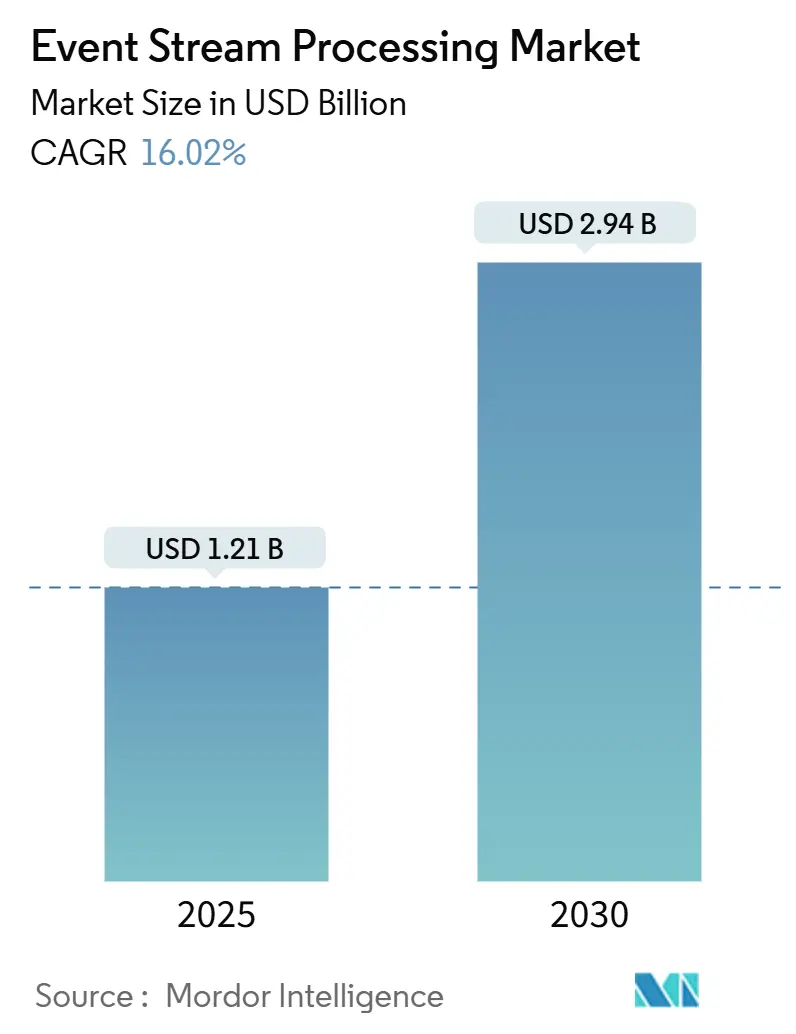
Event Stream Processing Market Analysis by Mordor Intelligence
The event stream processing market size is estimated at USD 1.21 billion in 2024 and is expected to reach USD 2.94 billion by 2030, advancing at a 16.02% CAGR through the forecast period. Sustained demand for continuous intelligence, tighter fraud-detection requirements, and the pivot to Kubernetes-native data pipelines are sharpening the focus on ultra-low-latency analytics. Adoption is strongest in financial services, telecommunications, and manufacturing, where real-time telemetry improves risk controls, customer experience, and predictive maintenance. Location intelligence is moving from a niche into a mainstream workload, helped by cheaper IoT sensors and maturing geospatial data-fusion tools. Vendors differentiate through latency optimization, cloud portability, and integrated AI. Headwinds include divergent open-source engines that complicate standardization and rising on-premise capital expenditure driven by data-residency mandates in China and the EU.
Key Report Takeaways
- By deployment type, cloud accounted for a 58% share of the event stream processing market in 2024, while hybrid cloud architectures are projected to expand at an 18% CAGR between 2025-2030.
- By component, solutions led with 65.5% of the event stream processing market share in 2024; services are forecast to grow at 19% CAGR to 2030.
- By application, fraud detection held 18.8% of the event stream processing market size in 2024, whereas location intelligence is anticipated to surge at a 31.1% CAGR through 2030.
- By end-user, BFSI commanded 23.8% of the event stream processing market share in 2024; the telecommunications segment will register the fastest 28.9% CAGR over the forecast period.
- By geography, North America retained a 38% revenue share of the event stream processing market in 2024; Asia-Pacific is on track to post a 17% CAGR through 2030.
Global Event Stream Processing Market Trends and Insights
Drivers Impact Analysis
| Driver | (~) % Impact on CAGR Forecast | Geographic Relevance | Impact Timeline | |
|---|---|---|---|---|
| North-American Kubernetes-native Data Pipelines | +3.2% | North America, with spillover to Europe | Short term (≤2 yrs) | |
| MiFID III Real-time Reporting | +2.8% | Europe, with global impact on financial firms | Medium term (≈3-4 yrs) | |
| 5G SA Network Telemetry | +2.4% | APAC core, spillover to global telecom | Medium term (≈3-4 yrs) | |
| Industry-4.0 Predictive-Maintenance Sensors | +1.9% | Germany, Japan, with expansion to global manufacturing hubs | Long term (≥5 yrs) | |
| US Retail Self-Checkout Fraud Analytics | +1.6% | United States, with adoption in developed retail markets | Short term (≤2 yrs) | |
| OTT Video CX Monitoring Growth | +1.4% | India, Southeast Asia, with expansion to emerging markets | Medium term (≈3-4 yrs) | |
| Source: Mordor Intelligence | ||||
North-American Kubernetes-native Data Pipelines
Financial institutions, retailers, and telecom operators in the United States and Canada are re-architecting streaming workloads on Kubernetes to gain elastic scalability and 35% lower operational overhead [1]Confluent Inc., “Kubernetes Adoption and Data Streaming Trends 2024,” confluent.io . Containerization simplifies version upgrades and enables “bring your own cloud” models that detach compute from storage, reducing inter-zone networking fees. Early adopters report faster resource provisioning and higher developer productivity. Growing ecosystem maturity led by service meshes, GitOps, and serverless connectors further accelerates enterprise migration. The shift helps vendors secure larger managed-service contracts while locking in consumption-based revenue.
MiFID III Real-time Reporting
The European Council adopted revised MiFIR/MiFID II rules in February 2024, compelling investment firms to implement sub-millisecond trade reporting by 2026 [2]European Council, “Capital Markets Union: Council Adopts New Rules to Enhance Market Data Transparency,” consilium.europa.eu . Consolidated tapes for bonds, equities, and derivatives require continuous queries across vast data flows, boosting demand for latency-optimized streaming engines. Banks and trading venues are modernizing legacy tick-data systems with deterministic processing and microsecond time stamps. Vendors able to certify compliance gain preferential access to strategic accounts. Secondary impacts include wider uptake of precision time-protocol hardware and deterministic networking across European data centers.
5G SA Network Telemetry Across APAC
Operators in Japan, South Korea, and Australia generate multi-terabyte telemetry feeds per day as 5G Stand-Alone traffic ramps. ESP platforms ingest these feeds to flag cell-site anomalies, optimize spectrum allocation, and trigger self-healing loops. NTT DOCOMO’s Open RAN trial with StarHub used real-time streaming analytics to fine-tune multi-vendor baseband stacks [3]NTT DOCOMO, “5G Open RAN Lab Trial with StarHub Completed,” nttdocomo.com . Similar initiatives across Singapore, Korea, and India anchor regional demand. Telcos monetize insights as premium network-as-a-service offerings for factories and media firms, extending the addressable event stream processing market.
Industry-4.0 Predictive-Maintenance Sensors
German and Japanese manufacturers embed high-frequency vibration and temperature sensors that emit continuous data to streaming backbones. A European automotive plant achieved a 25% downtime reduction after integrating IO-Link telemetry with an ESP-driven anomaly-detection model [4]Assembly Magazine, “Predictive Maintenance with IO-Link Reduces Downtime by 25%,” assemblymag.com . The convergence of OPC UA, MQTT, and edge AI brings OT and IT closer, elevating ESP from pilot to plant-wide standard. Vendors with robust edge runtimes and data-fusion toolkits capture share in rigorous industrial environments.
Restraints Impact Analysis
| Restraint | (~) % Impact on CAGR Forecast | Geographic Relevance | Impact Timeline |
|---|---|---|---|
| Proliferation of Divergent Open-Source Engines | -1.7 | Global | Short term (≤2 yrs) |
| China and EU Data-Residency Mandates | -2.3 | China, EU, with global impact on multinational corporations | Medium term (≈3-4 yrs) |
| Scarcity of Apache Flink / Kafka-Streams Talent | -2.1 | Emerging markets, with spillover to developed regions | Long term (≥5 yrs) |
| High Cost of Sub-50 µs Infrastructure | -1.5 | Global financial centers, concentrated in major trading hubs | Short term (≤2 yrs) |
| Source: Mordor Intelligence | |||
Proliferation of Divergent Open-Source Engines
Enterprise architects juggle Kafka, Flink, Spark Streaming, Redpanda, and RisingWave, each with unique APIs, state-management strategies, and monitoring stacks. Fragmentation increases learning curves and complicates global standards, with 97% of firms citing skills shortages in advanced streaming frameworks. Integration budgets swell, governance weakens, and multi-cloud portability suffers. Smaller teams gravitate to managed “opinionated” services, but lock-in risks persist, slowing overall adoption among cautious industries such as healthcare and utilities.
China an EU Data-Residency Mandates
China’s network data-security rules effective January 2025 and the EU’s evolving data-protection framework restrict cross-border data flows, forcing local processing footprints. Multinationals invest in additional on-premise clusters, redundant storage, and staff with regional compliance expertise. Capital expenditure rises sharply, especially for low-latency workloads that cannot tolerate data-diode buffering. Cloud vendors respond with local zones and sovereign-cloud variants, yet procurement cycles lengthen, postponing some large-scale migrations.
Segment Analysis
By Deployment Type: Cloud Dominance Sustains Hybrid Expansion
The cloud segment captured 58% of the event stream processing market share in 2024 as enterprises favored elasticity and managed-service convenience. Hyperscalers bundle low-latency messaging, serverless compute, and AI accelerators, lowering entry barriers for new workloads. “Bring your own cloud” deployment decouples compute from object storage, yielding 5–10× cost gains and widening the use-case funnel. Over the forecast horizon, an 18% CAGR underscores the sustained preference for cloud-first models, yet hybrid topologies persist for latency-sensitive edge sites and data-sovereignty use cases.
On-premise installations remain essential in capital markets, defense, and regulated telecom cores. Hardware-assisted time-stamping and co-located analytics deliver microsecond determinism unattainable across wide-area links. Data-residency rules in China and the EU reinforce the need for local clusters. Consequently, hybrid orchestration frameworks that move workloads between cloud and data center gain ground, helping vendors secure multi-year transformation contracts while mitigating churn.
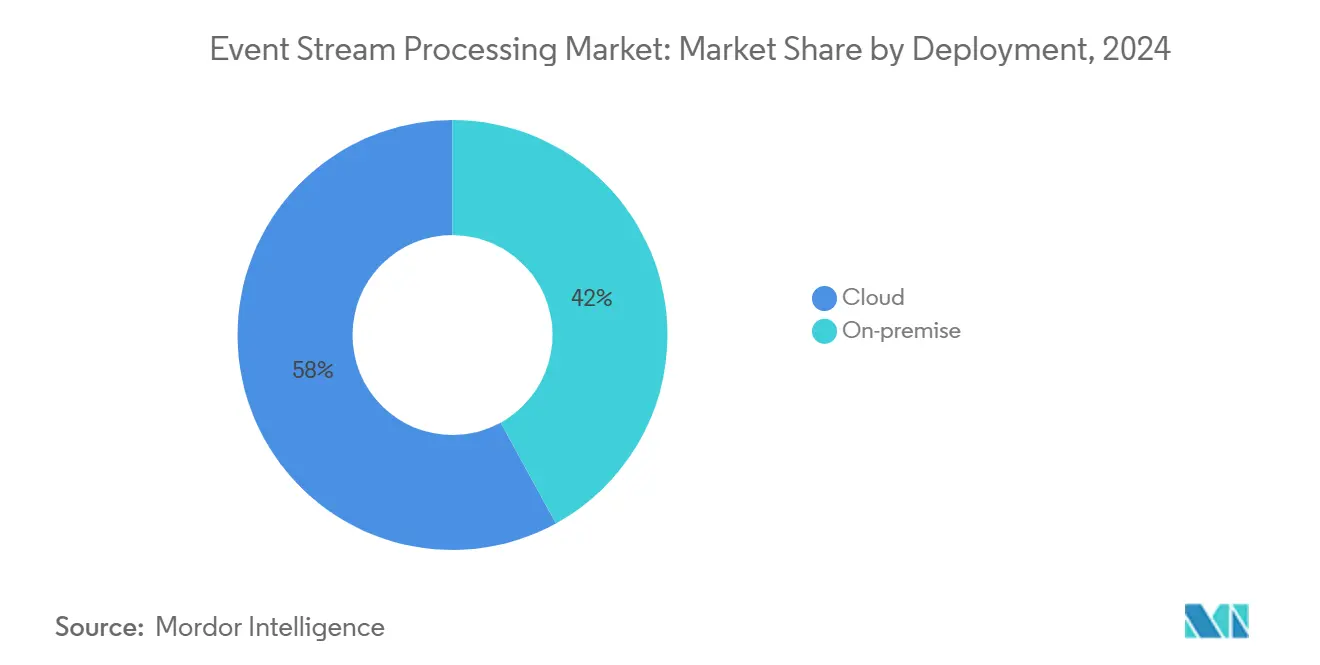
By Component: Solutions Command Spend While Services Accelerate
Solutions accounted for 65.5% of the event stream processing market size in 2024, fueled by continuous engine innovation and AI-infused analytics layers. Vendors integrate SQL-like pattern-matching, data-lineage tracking, and built-in governance, shrinking time to insight. Managed runtime upgrades and unified monitoring further lower operational barriers.
Services consulting, implementation, and managed operations grow faster at 19% CAGR as firms tackle skills gaps. Banks and telcos engage specialist teams to design streaming reference architectures, implement CI/CD pipelines, and harden security. Training services carve a parallel revenue channel, with certification programs that accelerate developer onboarding. Over time, services revenues rise as hybrid and edge deployments introduce architectural complexity beyond the scope of product licenses alone.
By Application: Fraud Detection Leads While Location Intelligence Surges
Fraud detection contributed 18.8% to the event stream processing market size in 2024, reflecting the priority financial firms place on real-time risk mitigation. Digital lenders ingest card swipes, web-session data, and device fingerprints to flag anomalies before authorization, saving millions in chargebacks. Continuous model retraining on streaming features tightens recall without sacrificing precision, driving incremental spending on high-throughput engines and feature stores.
Location intelligence, expanding at a 31.1% CAGR, capitalizes on pervasive GPS sensors, vehicle telematics, and drone imagery. Retailers refine site selection, logistics firms reroute fleets around dynamic constraints, and public-safety agencies orchestrate disaster responses. Geospatial data-fusion vendors partner with ESP providers to combine vector tiles, satellite feeds, and social-media signals. The integration accelerates adoption as users gain spatial awareness in familiar SQL paradigms.
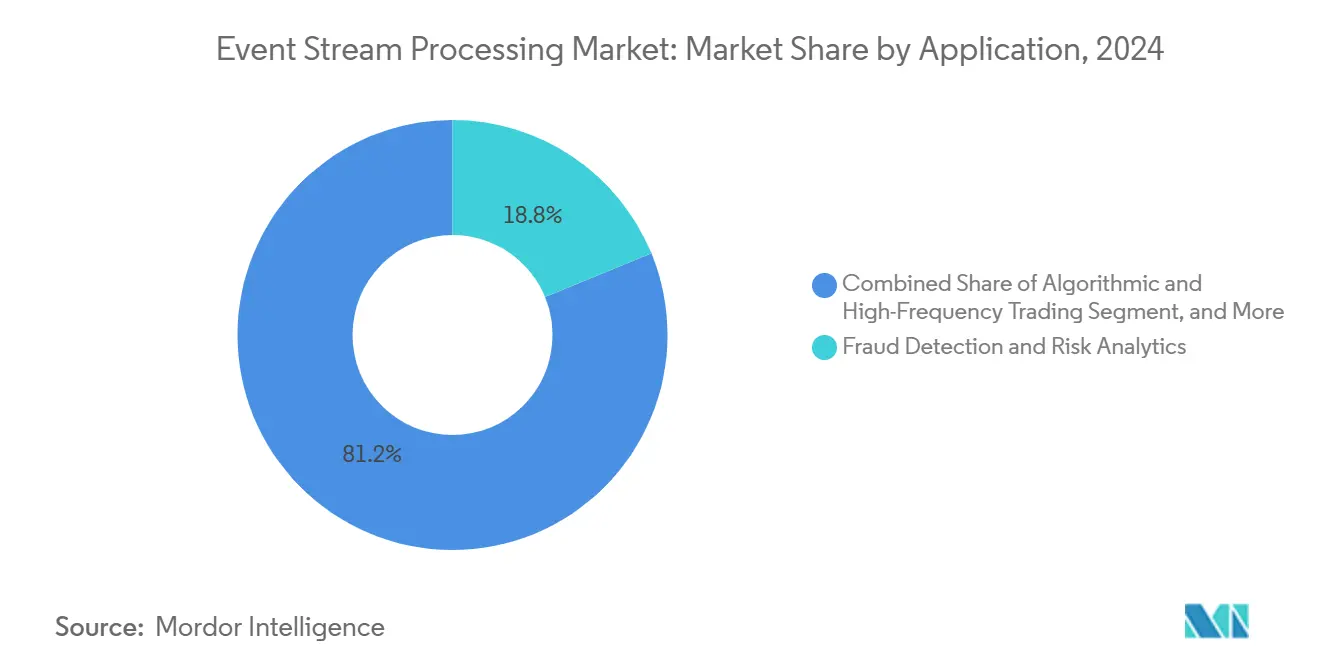
Note: Segment shares of all individual segments available upon report purchase
By End-User: BFSI Dominates While Telecom Accelerates
The BFSI sector held 23.8% of the event stream processing market share in 2024, propelled by high-frequency trading, anti-money-laundering analytics, and hyper-personalized banking. Capital One streams data from 100 million accounts to tailor offers and block fraudulent actions in real time. Regulatory scrutiny around trade reporting and liquidity risk intensifies the reliance on deterministic processing and lineage tracking.
Telecommunications, set to grow at 28.9% CAGR, rides the 5G Stand-Alone wave. Operators capture cell-level metrics, customer experience indicators, and network-slice utilization to optimize service quality and open premium SLA-backed tiers for enterprises. Edge-cloud convergence and Open RAN trials broaden the range of deployable micro-services, embedding ESP deep in the radio access stack.
Geography Analysis
North America accounted for 38% of global revenue in 2024, buoyed by vibrant technology ecosystems and deep fintech investments. Large banks demonstrate reference architectures at industry forums showing latency figures under 5 milliseconds on Kubernetes-native pipelines. Upcoming sovereign multizone regions from hyperscalers reinforce adoption among public-sector entities that require in-country data processing. Venture funding flows to ESP platform start-ups that target AI-enhanced observability, confirming sustained innovation momentum.
Asia-Pacific is the fastest-growing territory with a projected 17% CAGR. Japan and South Korea lead 5G SA deployments, while China promotes local-cloud frameworks to align with cybersecurity law. Industrial conglomerates deploy predictive-maintenance pipelines that fuse robotic telemetry and ERP signals, reinforcing the event stream processing market in manufacturing. Governments champion digital-trade corridors, encouraging cross-border e-invoicing platforms that rely on streaming fraud-analytics backbones.
Europe presents balanced growth anchored in regulatory transformation and Industry 4.0 investments. MiFID III drives front-office technology upgrades, while automotive hubs in Germany deploy edge streaming to trim energy consumption. The AI-NET-ANIARA research consortium showcases live predictive-maintenance blueprints validated in production plants, accelerating diffusion across mid-tier suppliers. Sovereign-cloud initiatives in France and Spain stimulate regional ESP spin-ups that bundle compliance tooling out of the box.
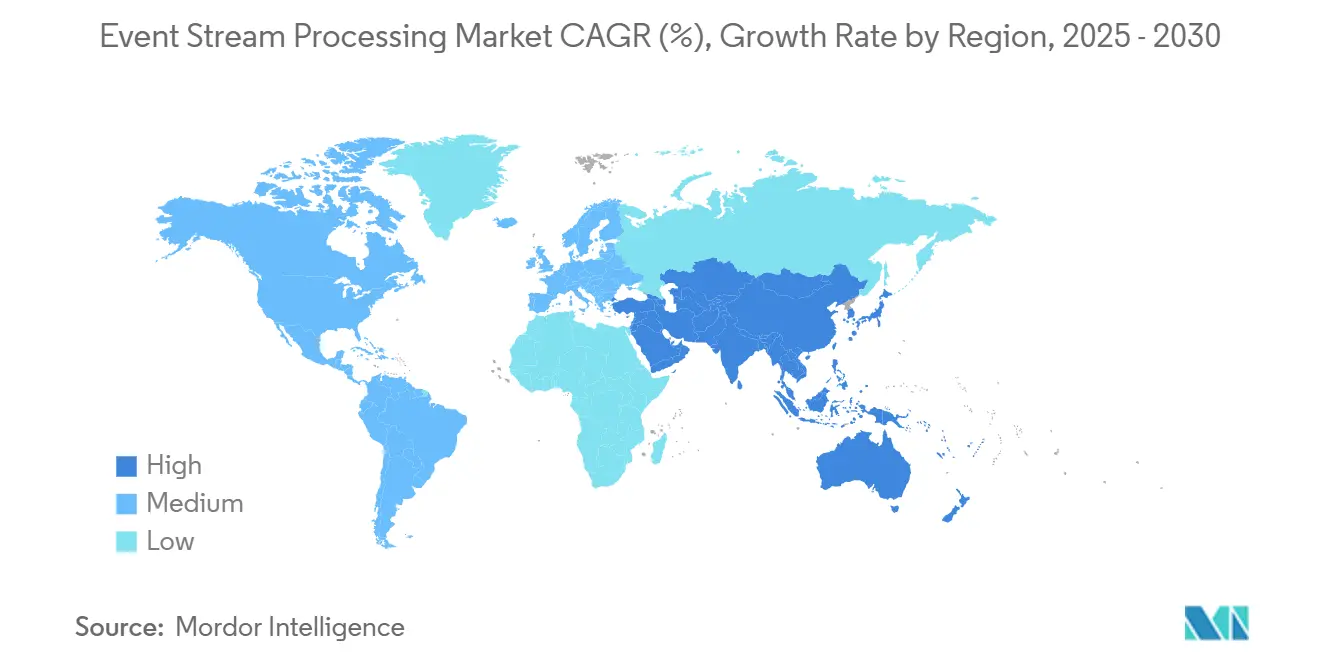
Competitive Landscape
The event stream processing market exhibits moderate concentration. Confluent, IBM, AWS, Microsoft, and Google hold dominant platform positions. Confluent strengthened its moat by acquiring WarpStream in January 2025, absorbing a cost-efficient BYOC architecture that decouples compute and storage. IBM expanded edge-delivery patents for multi-access services, signaling deeper integration of ESP with telco and industrial edge.
Strategic alliances define differentiation. The February 2025 Confluent-Databricks pact enables bidirectional streaming between Lakehouse tables and operational topics, marrying batch analytics and continuous intelligence. Google Cloud embeds continuous queries in BigQuery, eliminating ETL steps for near-instant dashboards. Redpanda Data attracts developers seeking Kafka-API compatibility without ZooKeeper, while Hazelcast targets memory-centric deployments that require sub-millisecond consistency.
Vendor roadmaps converge on AI infusion. Confluent Cloud Q1 2025 added Flink AI operators for real-time feature engineering. AWS integrates SageMaker with Kinesis Data Streams for low-code anomaly detection. Smaller players differentiate through specialized connectors Ververica for Flink SQL, StreamNative for Pulsar and through simplified day-2 operations that appeal to enterprises with lean site-reliability teams.
Event Stream Processing Industry Leaders
-
Confluent Inc.
-
IBM Corporation
-
Amazon Web Services Inc.
-
Microsoft Corporation
-
Google LLC
- *Disclaimer: Major Players sorted in no particular order
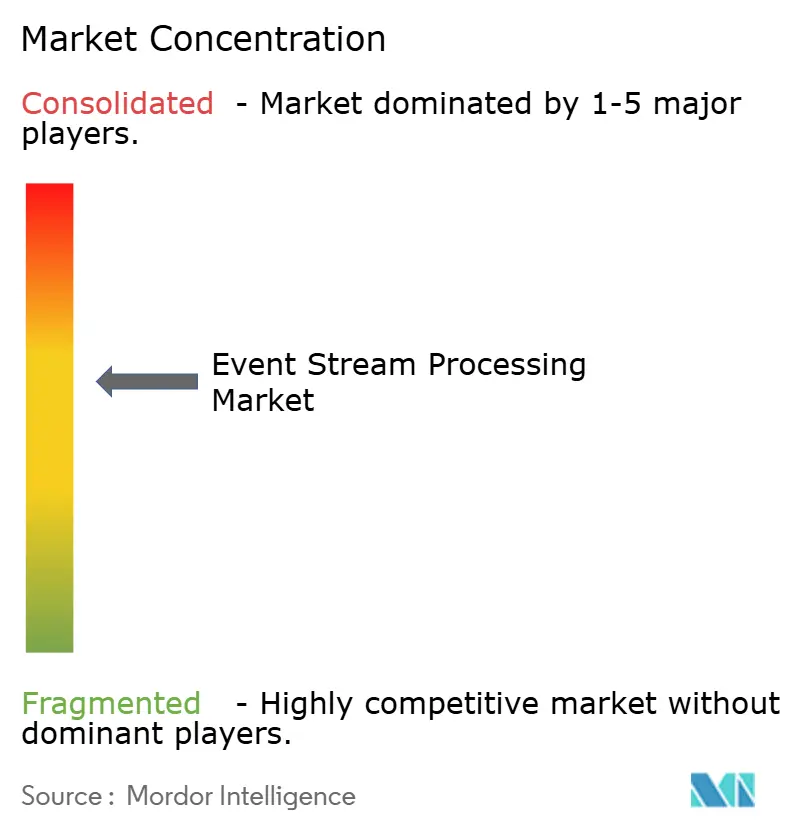
Recent Industry Developments
- March 2025: Confluent released Confluent Platform 7.9, expanding data streaming features and usability.
- March 2025: Confluent Cloud Q1 ’25 launched Tableflow, Freight clusters, and Flink AI enhancements.
- January 2025: Confluent acquired WarpStream to bolster BYOC streaming performance.
- August 2024: BM introduced StreamSets for hybrid real-time integration workloads.
Research Methodology Framework and Report Scope
Market Definitions and Key Coverage
Our study defines the event stream processing market as the revenue generated worldwide from purpose-built software platforms, engines, and companion services that ingest, enrich, and analyze continuous data flows in real or near-real time to trigger actionable insights.
Scope exclusion: revenue linked purely to batch analytics stacks, log-only management tools, or generic message brokers is excluded.
Segmentation Overview
- By Deployment Type (Value)
- Cloud
- On-premise
- By Component (Value)
- Solutions
- Stream Processing Engines
- Streaming Analytics Software
- Event Visualization and Dashboarding
- Services
- Professional Services
- Managed Services
- Solutions
- By Application (Value)
- Fraud Detection and Risk Analytics
- Algorithmic and High-Frequency Trading
- Process and Operations Monitoring
- Location Intelligence and Geospatial Analytics
- Sales and Marketing Personalization
- Customer Experience and Sentiment Analysis
- Others
- By End-User Vertical (Value)
- IT and Telecommunications
- BFSI
- Manufacturing
- Retail and eCommerce
- Energy and Utilities
- Healthcare and Life Sciences
- Transportation and Logistics
- Others
- By Geography (Value)
- North America
- United States
- Canada
- Latin America
- Brazil
- Argentina
- Mexico
- Rest of Latin America
- Europe
- Germany
- United Kingdom
- France
- Italy
- Spain
- Rest of Europe
- Asia-Pacific
- China
- Japan
- South Korea
- India
- Australia
- New Zealand
- Saudi Arabia
- Rest of Asia-Pacific
- UAE
- Middle East and Africa
- Rest of GCC
- United Arab Emirates
- Saudi Arabia
- South Africa
- Rest of Middle East and Africa
- North America
Detailed Research Methodology and Data Validation
Primary Research
Mordor analysts hold structured calls with solution architects at cloud providers, chief data officers across BFSI, and OT leads in manufacturing hubs in North America, Europe, and Asia-Pacific. The conversations verify price bands, deployment penetration, and regional adoption triggers that secondary material cannot fully surface.
Desk Research
We start with publicly available tier-1 datasets that anchor volumes and spending patterns, such as US Bureau of Labor Statistics ICT spend, Eurostat Digital Economy indicators, and UN COMTRADE sensor export flows. Trade-body portals like the Linux Foundation's LF Edge and TM Forum add implementation counts, while peer-reviewed journals in IEEE Xplore surface latency benchmarks for stream engines. Subscription resources inside Mordor, including Dow Jones Factiva for deal alerts and D&B Hoovers for vendor financial splits, let us align technology roll-outs with real revenue flows. This list is illustrative; many other sources underpin our desk work.
Market-Sizing & Forecasting
A top-down demand-pool reconstruction converts enterprise IT spending on real-time analytics into a dedicated stream-processing outlay, drawing on indicators such as Kafka cluster counts, 5G standalone base-station rollouts, fraud-case volumes, average streaming-engine annual contract value, and sensor node shipments. Results are then checked through sampled supplier roll-ups and channel ASP × volume tests. Forecasts use multivariate regression that ties CAGR projections to growth in edge IoT nodes, cloud data-warehouse queries, and open-source commit velocity, with scenario ranges vetted by our primary contacts.
Data Validation & Update Cycle
Before sign-off, two senior reviewers stress-test anomalies against historical patterns and fresh newsfeeds. Models refresh every twelve months and are re-opened sooner when a material event, like a landmark acquisition or regulatory mandate, moves the baseline. Clients therefore receive the latest vetted view each time.
Why Our Event Stream Processing Baseline Commands Reliability
Published estimates frequently diverge because firms pick different component mixes, conversion rates, and refresh cadences.
We acknowledge these variables upfront and show below how they shift the headline number.
Benchmark comparison
| Market Size | Anonymized source | Primary gap driver |
|---|---|---|
| USD 1.21 B (2024) | Mordor Intelligence | - |
| USD 2.12 B (2024) | Regional Consultancy A | Bundles data-integration platforms and advisory revenue |
| USD 0.77 B (2024) | Trade Journal B | Focuses on SMB software licenses and omits managed cloud services |
| USD 0.93 B (2023) | Industry Association C | Uses earlier base year and excludes support subscriptions |
The comparison shows that when scope widens to adjacent integration tools, values inflate, while narrow license-only counting pulls totals down. Mordor's disciplined variable selection, annual refresh, and dual-path validation give decision-makers a balanced point they can trace back to clear assumptions and replicated steps.
Key Questions Answered in the Report
What is the current Event Stream Processing Market size?
The Event Stream Processing Market is projected to register a CAGR of 15.7% during the forecast period (2025-2030)
Who are the key players in Event Stream Processing Market?
IBM Corporation, Microsoft Corporation, Google Inc., Oracle Corporation and Amazon Web Services Inc. are the major companies operating in the Event Stream Processing Market.
Which is the fastest growing region in Event Stream Processing Market?
Asia-Pacific is estimated to grow at the highest CAGR over the forecast period (2025-2030).
Which region has the biggest share in Event Stream Processing Market?
In 2025, the North America accounts for the largest market share in Event Stream Processing Market.
What years does this Event Stream Processing Market cover?
The report covers the Event Stream Processing Market historical market size for years: 2019, 2020, 2021, 2022, 2023 and 2024. The report also forecasts the Event Stream Processing Market size for years: 2025, 2026, 2027, 2028, 2029 and 2030.
Page last updated on:
